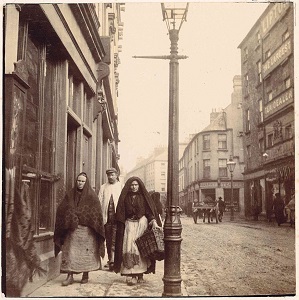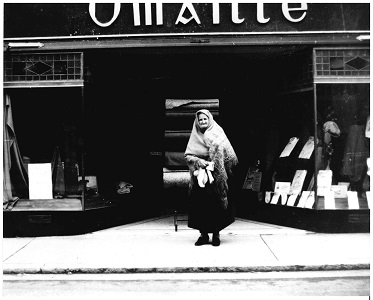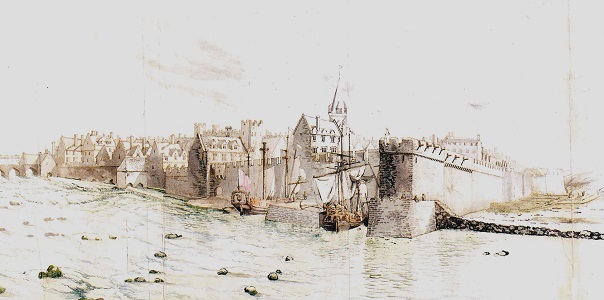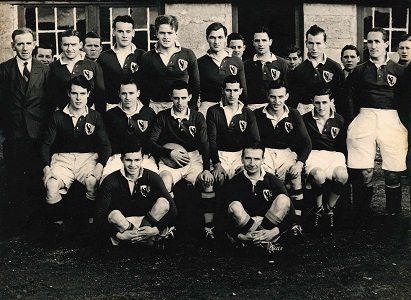Old Galway
ST. MARY’S COLLEGE, THE EARLY DAYS

by Tom Kenny
It was about this time of year, May 26th, 1910 that the foundation stone of St. Mary’s College was laid. It was not, however, the first St. Mary’s College. Father John Paul O’Toole, born in Galway in 1804, was one of the last priests ordained during the wardenship. He was based in Paris and Rome but was always conscious of his own difficulty in obtaining a secondary education in Galway, so he decided to return to Galway in 1843 and open a school here. His main difficulty was finding a premises but happily, he managed to secure “West House”, a detached residence with extensive grounds situated on Helen Street. He bought it from John Lushington Reilly, a great benefactor of the town and neighbourhood, especially during the famine of 1822.
Fr. O’Toole adapted the building and opened the school on March 1st, 1844 and it flourished from the start. Two years later, the Bishop raised it to the status of Diocesan College. However, the success was short-lived. The construction of UCG was underway and it seemed it was only a matter of time before Fr. O’Toole was made a professor there. In anticipation of this, he closed the school in 1849 and the following year, he was appointed Vice-President and a professor in UCG. However, the Bishops regarded the undenominational system of education there as unsafe for Catholics and forbade any priests to work there. So, Fr. O’Toole resigned and went to England to do parish work.
SWIMMING IN SALTHILL

by Tom Kenny
Swimming is the self-propulsion of a person through water as a form of recreation, exercise or survival. It has numerous health benefits and is good for all ages and all levels of fitness. It is among the top public recreational activities. One can swim in the sea, the lake or river. People have always swam in Salthill and the area has also been attracting tourists for some 200 years now. Some came unprepared and there were several instances in Victorian times where day trippers came without thinking of togs but could not resist the temptation to have a dip in the sea in the nude, scandalising walkers along the coast road.
It is hard to believe today that for a major part of the last century, there was no mixed bathing allowed in Salthill. It was a men-only zone in Blackrock and the Ladies beach was confined to women and children. The so-called family resort in fact divided families. Bishop Browne met a lady in a bikini on the Prom and gave her a lecture – You cannot appear in public dressed like that etc. When he finished his rant she simply said “Which bit would you like me to remove first”.
60 YEARS OF THE STUDENT’S UNION

by Tom Kenny
The University College Galway student’s union was originally established in 1911 as the Student’s Representative Council. This council lasted only a short time but its reestablishment was proposed in 1913 and by the 1920s, it was firmly established. In the 1960s, it was formally developed into the University Student’s Union, then known as Comhairle Teachta na Mac Leinn or CTM for short. It was formed in 1964, the function of the Union as per the Constitution was “to represent its members and promote, defend and vindicate the rights of its member at all levels of society”.
The first president was Michael D. Higgins as you can see from his membership card. They very quickly swung into action and organised some 600 students to march in protest at “the poor relations generally between the University and the local community” as many hotels refused to take visiting students, landladies discriminated against students in summer etc. The protest started at the archway and finished at Seapoint.
Here are some of their activities over the years.
In 1970, 1,000 students protested over not being allowed to use the Aula Maxima during College Week for an intervarsity ballad competition. In 1971, a small reading room was taken away from students against the wishes of the student body and without authorisation of the Governing body. This led to the occupation of the Common Room by 500 students and the suspension of three of them.
COLLEGE STAFF EXHIBITION

by Tom Kenny
Our first photograph today is of Mrs. Anne Creaven, or “Ma” Creaven as she was known to generations of students and staff at UCG. She ran the coffee shop, a small intimate split level building which had originally been the College Sports Hall. It could only cater for a small number of people at one time, but then, student numbers were small in College at then.
In the early sixties, it was demolished and a new, much larger building put in its place. There was one constant throughout – Ma Creaven – and whether it was in the original or enlarged version, there was absolutely no doubt as to who was in charge. She was like a sergeant major, she was usually at the till dressed in a tweed suit in winter, in a twin-set in summer. She had a booming voice and if she thought you were dossing or worse, dodging lectures, she would let a roar at you and accuse you in no uncertain terms of whatever misdemeanour you were guilty of. And to make the punishment worse, everyone in the coffee shop and many others throughout the university, heard her accusations as well. She was invariably correct in her assessment and it was not confined to students, lecturers and professors suffered the same indignities too.
LIPTONS IN SHOP STREET

by Tom Kenny
Our first image today is a beautiful study of part of Shop Street c.1900. It is one of a number of Galway city photographs that are in an old album belonging to Norman Healy whom we thank for sharing it with us. The two women in the foreground are in their working clothes, plain black shawls and práiscíns which were heavy canvas working aprons used to carry vegetables or maybe fish in, or wear when they were washing clothes. One is carrying a basket which probably contained product she had to sell, possibly eggs, country butter or vegetables. The other lady may have had a basket strapped to her back. The gentleman behind is wearing an impressive white báinín jacket.
The gaslight in front, and the one on the corner are both elegant structures which must have, when lit up, created an interesting atmosphere on the street, probably poor lighting by today’s standards but a vast improvement on the times when there was no street lighting. The tramlines can be seen on the street. The building on the corner (Powell’s today) was known as Maggie Murphy’s pub and tearooms. The building on the near corner was occupied by The River Plate Frozen Meat Company, and next door was Liptons which, the very large signage on the imposing façade tells us, was “The Largest Tea Dealer”.
THE END OF AN ERA

by Tom Kenny
The Ó’Máille family originally came from Portacarron near Oughterard which accounted for their Irish speaking background. Their landlord, Mrs. Annie Nolan evicted them from their holding and they spent a number of years in temporary accommodation. When Mrs. Nolan’s son wanted to run in an election, Isaac Butt, the Irish Parliamentary Party leader stipulated that his nomination would not be ratified until such time as his mother reinstated her evicted tenants and so the Ó’Máille family were awarded a fine farm holing in Brackloon in the parish of Corofin, east of the Corrib.
Padraic Ó Máille did an extensive apprenticeship working in Castlebar, before he, his brothers Seán and Stiofán together with their sister Mary (known to all as Cis) commenced trading at Number 54, Dominick Street in 1938. They used to cycle into Galway every morning and home again in the evening. They had the imagination and foresight to develop trade in home-spun yarns, hand-woven tweed and made-to-measure clothing. Pádraic was the first businessman in Ireland to buy and sell traditional hand-knitted goods.
OUR FORTIFIED CITY

by Tom Kenny
The town of Galway was virtually an independent city state, self-contained politically and ecclesiastically, relying on its own resources as it was cut off from the central English authority until the 16th century. Then, the Tudors began to extend their influence westwards so that the city gradually came totally under their dominion. The real symbol of that growing influence was the fortifications, four in number, raised to defend this all-important location against all enemies, notably France and Spain.
The first mention of fortifications occurs in 1548 when Edward VI asked the Mayor and Council of Galway to fortify the port; they were willing but pleaded a lack of funds, the government were willing to advise but not to pay, so nothing happened. The establishment of a garrison of English soldiers here proved unpopular with the natives and gave ‘rebels’ in the west an excuse to attack the city. Some Galwegian merchants whose Spanish trade had been ruined by the English were now trafficking guns and supplies to those rebels. And then, of course, there was the danger from Spain itself, so in 1584, the first fortifications were built at Ceann-a-Bhalla.
CYRIL MAHONY, A SUPERB COMIC ACTOR

by Tom Kenny
Cyril Mahony was born in February 1913 in the family home on Prospect Hill. His mother was Mary Teresa Cunniffe from Loughrea and his father Gerry was a member of the R.I.C. who at one time was stationed in Belfast. He eventually left the force and came back to his mother’s house on Prospect Hill. She was Anne Flaherty from Conamara, a native speaker and a well-known maternity nurse.
Cyril was one of six children – Vin, Cyril, Maudie, Des, Piaras and Ita. Cyril went to the Monastery School from where he got a scholarship to the Bish. He used to serve mass in St. Patrick’s Church. He was very athletic, a fine sprinter and a very good rugby player, rejoicing in the nickname ‘Twinkletoes’. He played at scrumhalf and captained the first ever Connacht team not to be beaten by Leinster. The game was played in Kilkenny and speaking at the dinner afterwards, Cyril got a bit over excited and while he regretted Leinster winning, he was delighted that Connacht won. Austin Carrie who was sitting beside him, nudged him and said “It was a draw sir, a moral victory perhaps, but a draw nevertheless”.
